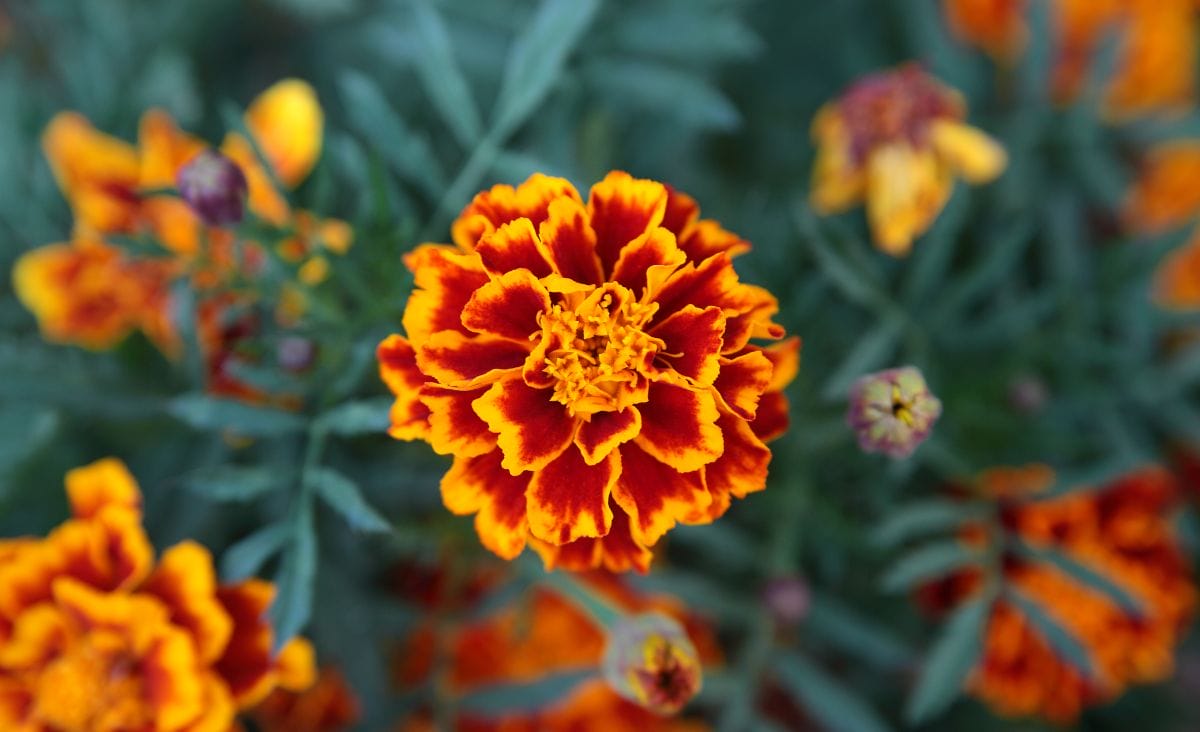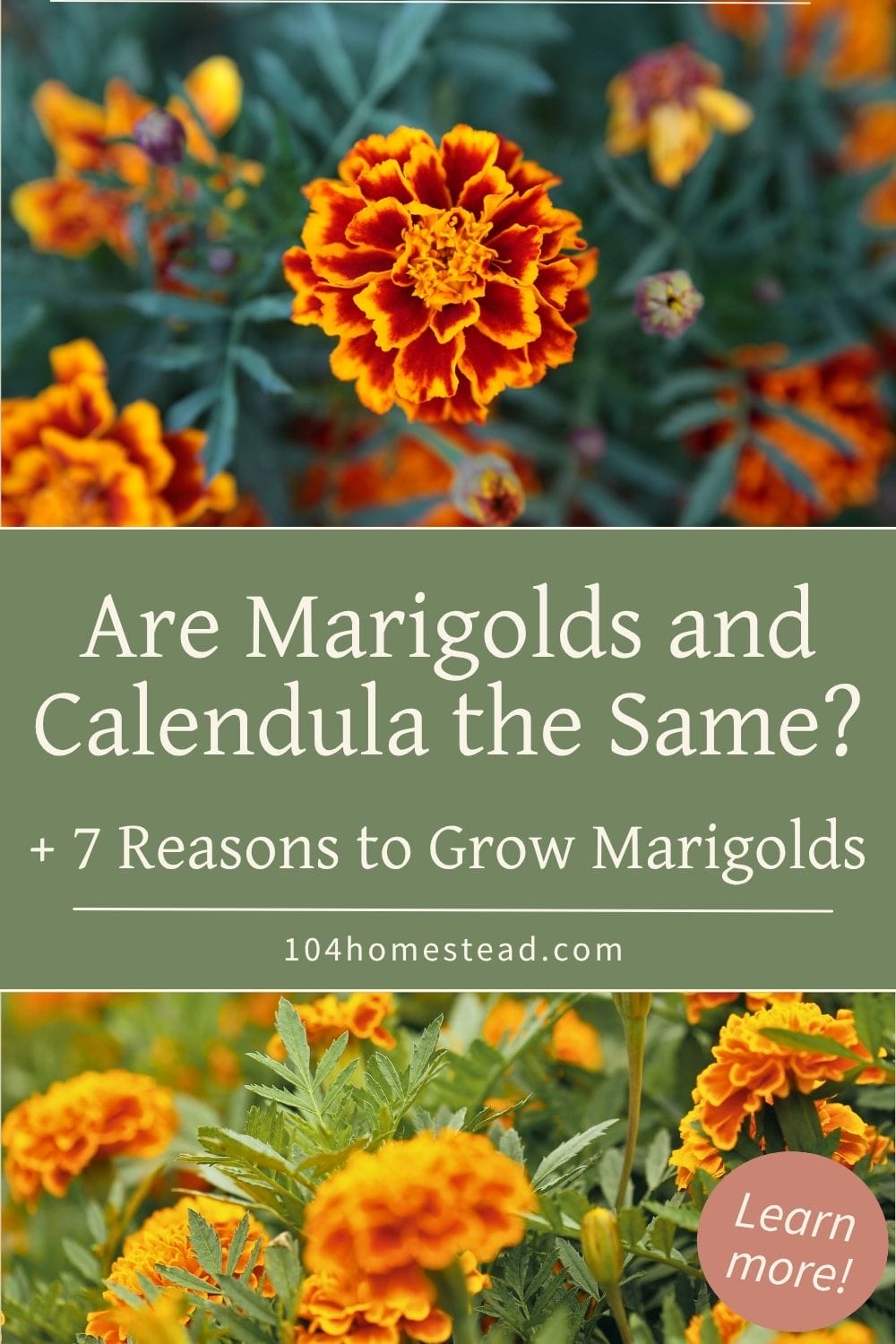Are Marigolds and Calendula the Same? Benefits of Marigolds
Learn the difference between marigolds and calendula—and why marigolds deserve a spot in your garden for pest control, pollinators, and healthy soil.

Gardeners love to debate things like mulch choices and seed starting setups—but one question that comes up again and again is this: Are marigolds and calendula the same plant?
The short answer? No, they’re not.
But I get why there’s confusion.
Calendula is often called “pot marigold,” but it’s a completely different plant from the classic marigolds (Tagetes species) you see filling out vegetable beds and garden borders. While calendula is prized for its medicinal uses and skin-soothing properties, marigolds bring a whole different set of benefits to your garden.
Both are beautiful, and both are useful—but in very different ways. But today, I want to focus on why marigolds (Tagetes) are absolutely worth a spot in your garden—and why I make room for them every single year.
Why Marigolds Deserve a Place in Your Garden
Calendula gets plenty of attention (rightfully so), but don’t overlook humble marigolds. These bright, cheery flowers pull their weight in the garden far beyond just looking pretty.
The Benefits of Growing Marigolds
Here’s what marigolds bring to the table—and why they’ve earned a permanent spot in my own garden beds.
They Help Deter Pests
Marigolds are famous for their pest-repelling abilities. Certain types, like French marigolds, can help deter root-knot nematodes when planted around susceptible crops. They’re also known to confuse or repel aphids and other small garden pests. While they’re not a magic shield, they’re a valuable tool in your natural pest management toolkit.
If you’re looking for more ways to protect your garden naturally, here are 7 natural garden pest control tricks that actually work fast.
They Attract Pollinators and Beneficial Insects
Marigolds aren’t just about keeping pests away—they help invite the good guys in, too. Bees, hoverflies, and ladybugs are all drawn to their blooms. More pollinators mean more success with your squash, cucumbers, and tomatoes. More beneficial insects mean fewer pest problems down the road.
They’re a Natural Companion Plant
You’ll often see marigolds recommended as companions for tomatoes, peppers, beans, and squash. They can help protect neighboring plants, fill in bare spots, and add a layer of biodiversity to your garden—all of which supports healthier, more resilient crops.
If you’re adding plants to help support pollinators and beneficial insects, here’s why you should also make space for hyssop in your garden.
They’re Easy to Grow (Even for Beginners)
Marigolds don’t ask for much. They thrive in poor soil, handle heat like champs, and bloom non-stop from early summer until frost with very little fuss. They’re practically tailor-made for new gardeners—or busy ones who don’t have time for fussy plants.
They Add Color and Beauty to Your Garden
Beyond their practical benefits, marigolds bring cheerful pops of orange, yellow, and red to garden beds. They’re just plain pretty—and sometimes, that’s reason enough to grow them.
They’re Edible (in Small Quantities)
Marigold petals (Tagetes species) are technically edible. They’re sometimes used as a garnish or to add color to salads. Just keep in mind they don’t have the same medicinal properties as calendula and are mostly grown for garden benefits, not kitchen remedies.
They Support Soil Health Through Trap Cropping
In larger garden systems, marigolds can be used as trap crops—luring pests away from more valuable vegetables. While this might not be necessary in every backyard garden, it’s another reason these flowers are often seen alongside rows of veggies.
Marigolds are just one way to make your garden more resilient. You might also enjoy these ideas on how to improve your garden with permaculture herbs.
FAQs About Marigolds vs. Calendula
Even after hearing all the benefits, you might still have a few lingering questions—especially with all the confusion out there.
Want to keep these marigold benefits handy when you’re planning your garden? Save this post on Pinterest so it’s easy to find later.

Marigolds might not have the same herbal reputation as calendula, but they’ve absolutely earned their place in the garden. They’re hardworking, dependable, and low-maintenance—and they give back so much more than they take.
Whether you’re tucking a few into your vegetable beds to keep pests at bay or planting a whole row to brighten things up, marigolds are one of those plants that quietly pull their weight all season long.
Thanks for spending a little time here with me today. I hope this post gave you a fresh appreciation for marigolds—and maybe even inspired you to plant a few this season.
From my homestead to yours,
Jessica

I like the marigold flowers more than any other flower, Magnolia is a good example for us to do great things.
What part of MAINE ARE YOU FROM? wE MOVED HERE TO bANGOR AREA FROM mINNESOTA IN jULY iT HAS
BEEN REAL INTERESTING .
We’re in the Mount Washington Valley area.
I am new to gardening. I have had a garden for 3 years now. I am good with cucumbers, lettuce, peppers, tomatoes. I cant seem to get radishes and onions to cooperate with me. Do you have any suggestions. Also, I am going to try broccoli this year, any pointers for that. I love to bake bread for the mission here, what do you recommend to be put into the bread for vitamin sake. I try to take bread to feed as many as I can but would like for it to have some vitamin goodness also.
Hi Gail!
My guess, as far as the trouble you’re having with onions and radishes, is that your soil isn’t draining properly. Neither of these root vegetables appreciates having wet feet. I’d either move them to a drier location or build up the bed a bit where they are located. Also be sure to thin them out according to the directions on the packet. They don’t like to compete for sun. If they are too shaded, all the effort will go into growing greens.
As for the bread, I’m not familiar with increasing the nutrients in bread. I’d check out your local library for a bread making book that discusses different grains and maybe sourdough options.
gail —
one way to increase the nutrition in bread is to make it with brown flour — wholegrain flour.
The marigold that you have pictured and calendula are two different plants. Calendula is sometimes called marigold, but it is not the same as the garden variety of marigold.
You are so right Donna. Although in the instances I gave they can be used interchangeably, by putting calendula in parenthesis like I did, it may cause confusion. I will fix that right away.
I am super excited about this post! I plant marigolds everywhere I can in the garden for the pest-deterring qualities. I never even thought about eating them…hmmm, may have to try some! I am currently growing a variety that my uncle has been cultivating for over 20 years. 🙂
They are chock full of fabulous vitamins 🙂
Marigolds are supposedly a deterrent to deer (and other much smaller pests). I have crazy possessed starving deer around here though, that are the bane of my existence. :/ I just had to share my misery…
I bet if you still had those huge thorny weeds the deer would stay away.